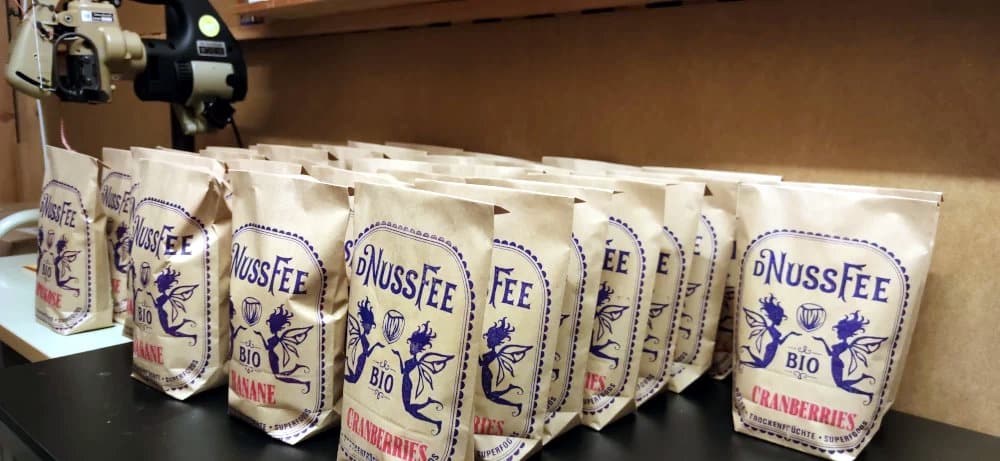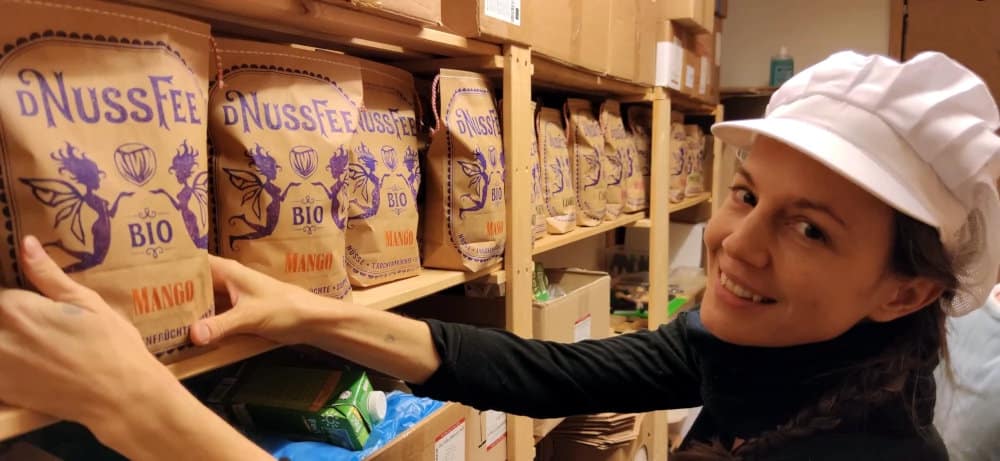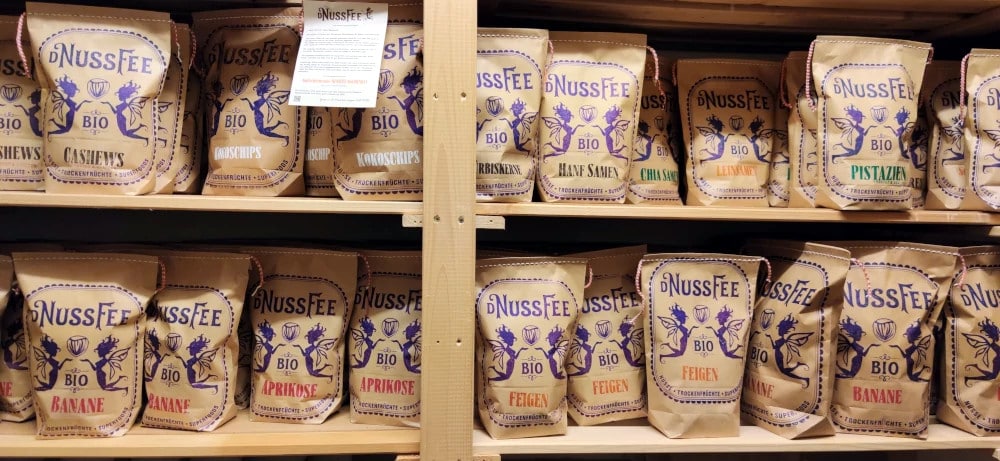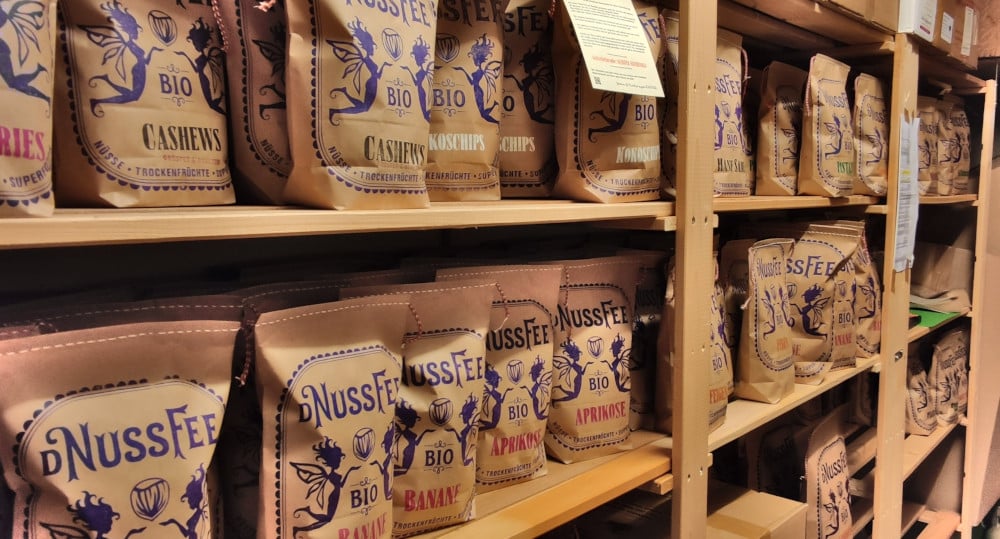D’NussFee plastic free packaging concept
D’NussFee will gladly explain our plastic-free packaging concept to you in the following.
Packaging
- The paper bags for the products are made of 100% cellulose. They are made of Kraft paper with an inside insert made of ultra-fine glassine paper.
- The label on the back of our bags is made of environmentally friendly grass paper
- The paper for the delivery bill as well as the climate-neutral shipping label is obtained from the remains of sugar cane and is not bleached with chemical agents.
- The shipping label bag is also made of fine, almost transparent cellulose
- The so called wet glue strips on the carton is made of recycled paper with a water soluble glue made of plant glue and are moistened similar to a stamp with a special machine before they close the cartons. This also has the advantage that nobody can open the box without damaging the adhesive tape, so you can be sure that your goods arrived as we sent them.
- The bags are hand stamped with water soluble ink and so we do not need another printed label
- The filling material is a cardboard paperthat has been awarded the Blue Angel and is particularly environmentally friendly
- The thread for sewing our bags is made of cotton (instead of the usual polyester thread)
- The tasting bags we sometimes send along are made of real cellophane, also called cellophane. The completely transparent, crackling bags look like plastic, but they are also made of 100% cellulose and can therefore also be disposed of in waste paper (just hold a lighter to it and light a corner, it smells like burnt paper).
Thus, everything that is not edible can be disposed of in the waste paper without any problems.
Website
- Our WebShop is climate neutral compensated via ClimatePartner.
Shipping info
- Our shipping partner DPD also ships climate-compensated as standard.
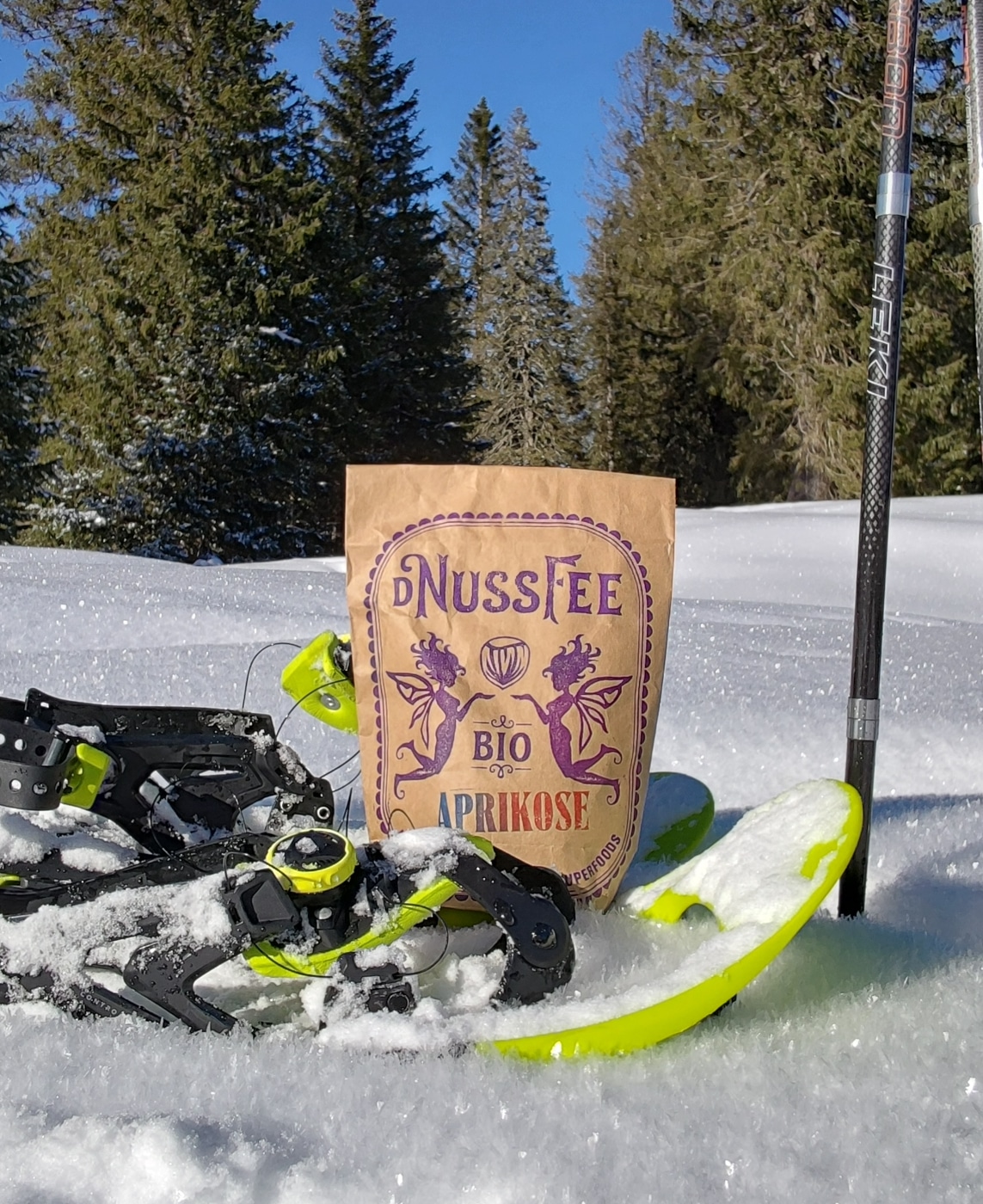
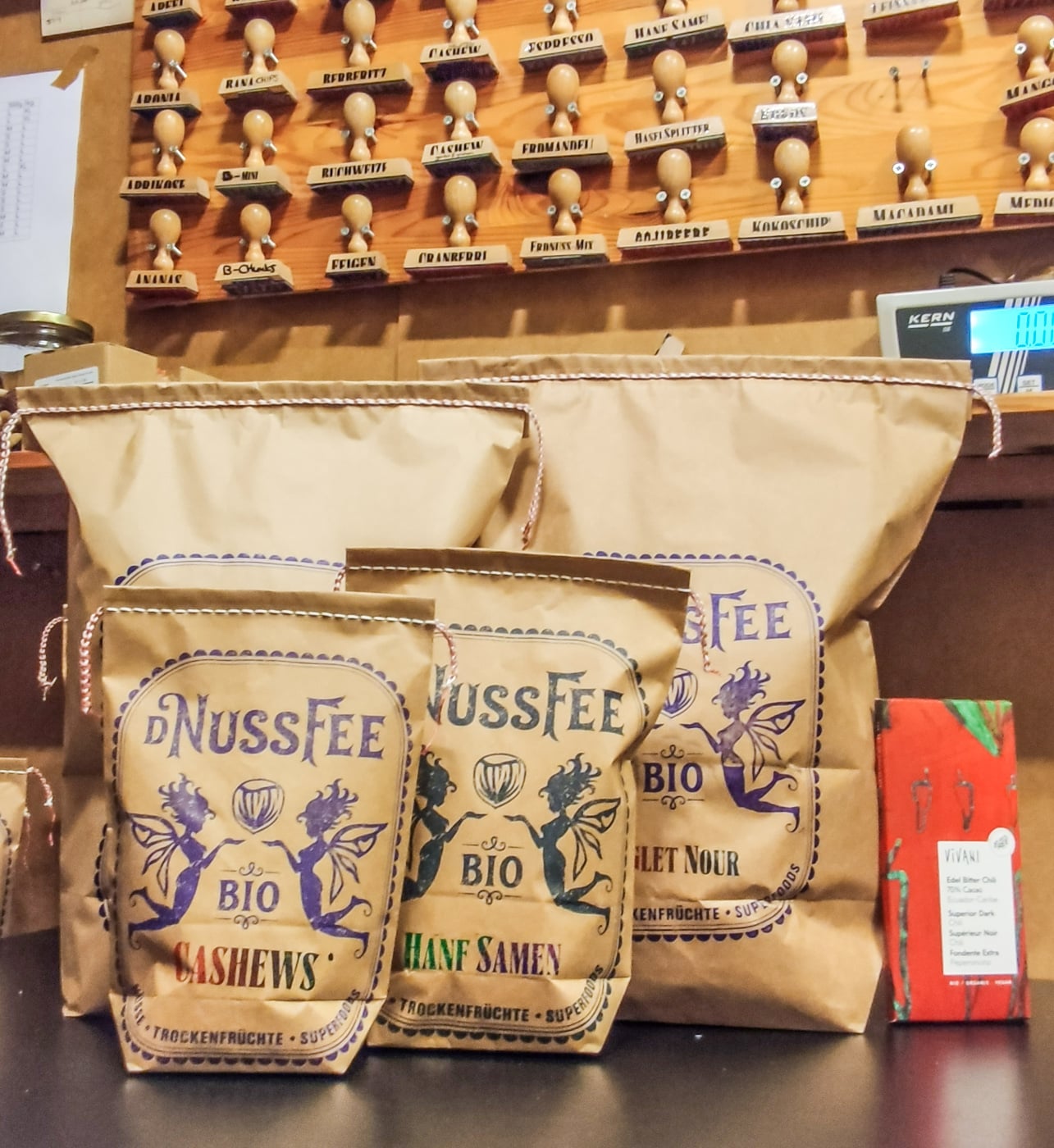
Video: how to easily open our paper bags
In the video we explain how to open our bags at the seam without much “fumbling”. Simply cut the thread on the right, unthread once and pull the red thread.
REALLY PLASTIC-FREE?
Why organic plastic is not an alternative
With our concept we want to show that you can actually produce completely plastic-free even in online retail. Because during our research we found that other shops like to plastic free “, although these often only refer to the sg” Bio plastic ”(Polypropylene PP) mostly made from corn starch. On closer inspection, however, this also turns out to be not very environmentally friendly, namely pretty much like plastics made from petroleum. In the following we would like to explain why we have actively decided against bio-plastic and why we are of the opinion that one should not adorn oneself with the word plastic-free when using bio-plastic.
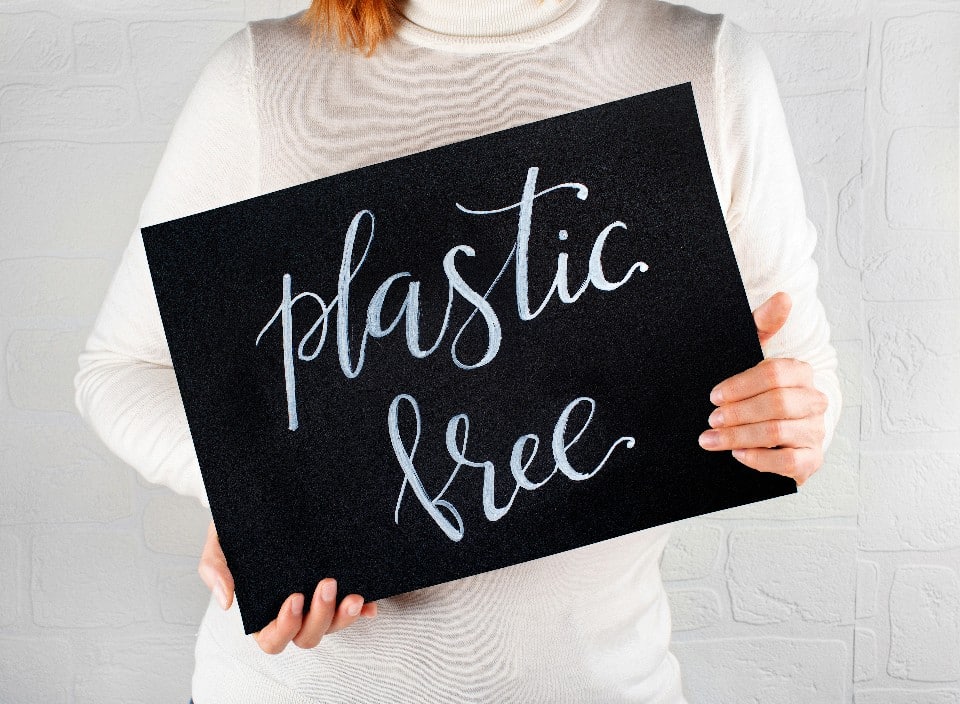
Switzerland is a top 3 consumer?
Oceancare.org has researched that Switzerland is one of the top 3 plastic consumer worldwide with more than 1 million tons of plastic per year, 40% is used for packaging material alone.
What many do not know – only a meager 10% of it is actually recycled, the majority is simply burned – which in turn releases a lot of CO2. Especially since around 100,000 tonnes are then exported abroad, where it is not possible to ensure what will then happen with them (it often ends up in large landfills in Southeast Asia or India). And even in beautiful Swiss nature, according to the Swiss Litter Report, a terrifying 10’000 – 13’000 kg of plastic waste ends up on the lake and river banks every month.
So – why not just use bio-plastics?
The basis of the Bio-plastics basically form renewable raw materials such as corn or sugar cane, which are then processed into a similarly durable bio-plastic. This saves crude oil and has a better CO2 balance, but these raw materials usually come from conventional monocultures and are therefore contaminated with pesticides, over-fertilized and not GMO-free. The loss of space for food production is also problematic when using bio-packaging.
In the search for suitable packaging for our needs, we found that almost all bio-eco-packaging always has an inner layer made of bio-polypropylene (PP) or PLA. Since these represent a similar shelf life and environmental impact in recycling, we could not call them “plastic-free” with a clear conscience.
The packaging material we use will consist of 100% (recycled) cellulose, with an inner layer made of cellulose-based glassine paper. The entire packaging is therefore fully biodegradable and can therefore be disposed of in the waste paper (or theoretically burned on a campfire).
Does your packaging also have disadvantages?
Of course, plastic has many advantages, especially for food. It is much cheaper than our packaging and the products have a long shelf life in it. But we all know the environmental consequences of the immense Plastic consumption Has. Since everyone usually has enough storage options at home, we see our packaging primarily as a means of transport so that the goods arrive safely with you. In the we explain how you best handle the food so that it stays fresh and tasty for a long time Storage tips .

